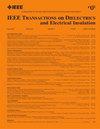Molecular Thermodynamic Evaluation of Various Cu-Doped ZIF-8 Ratios for SF6 Catalysis
IF 3.1
3区 工程技术
Q2 ENGINEERING, ELECTRICAL & ELECTRONIC
IEEE Transactions on Dielectrics and Electrical Insulation
Pub Date : 2024-11-11
DOI:10.1109/TDEI.2024.3495588
引用次数: 0
Abstract
SF6 is a greenhouse gas with strong greenhouse effect. How to rationally deal with waste SF6 has become an extensive research topic for scholars at home and abroad. Studies have shown that ZIF-8 has certain superiority as a catalyst, while metal doping in ZIF-8 may promote its catalytic ability. In this article, the undoped ZIF-8 model and the Cu-doped ZIF-8 model (Zn:Cu =1:5; Zn:Cu =3:3) were constructed, and the most stable adsorption structures of SF6 at three typical sites were obtained based on density-functional theory (DFT), with the 6-membered ring (6MR) window as the optimal adsorption site. The stable adsorption energy was the largest in the Zn:Cu =5:1 doped model (−98.352 kcal/mol), and during the adsorption process, the SF6 molecular bond lengths changed most drastically, and even the bond breaking phenomenon appeared. The catalytic ability of the Zn:Cu =3:3 doping model was in between that of the ZIF-8 and Zn:Cu =1:5 doping models. The results of the Mulliken charge transfer and the HOMO-LUMO energy level showed that in the Zn:Cu =5:1 doping model, the Cu atom can both transfer a large number of electrons (−0.606 e) to SF6 and enhance the ability of Zn atoms to lose electrons, effectively weakening the S-F bond strength of SF6 gas molecules and thus promoting SF6 gas molecule catalysis. The highest occupied molecular orbital (HOMO) wave function in the system is mainly distributed around the doped Cu atoms, the energy gap is significantly reduced, and the catalyst reactivity is enhanced.不同掺铜比例ZIF-8催化SF6的分子热力学评价
SF6是一种具有强烈温室效应的温室气体。如何合理处理废弃SF6已成为国内外学者广泛研究的课题。研究表明,ZIF-8作为催化剂具有一定的优越性,而在ZIF-8中掺杂金属可能会提高其催化能力。本文分别建立了未掺杂ZIF-8模型和掺杂Cu的ZIF-8模型(Zn:Cu =1:5;基于密度泛函理论(DFT)得到了SF6在3个典型位点上最稳定的吸附结构,其中6元环(6MR)窗口为最佳吸附位点。Zn:Cu =5:1掺杂模型的稳定吸附能最大(−98.352 kcal/mol),吸附过程中SF6分子键长变化最剧烈,甚至出现断键现象。Zn:Cu =3:3掺杂模型的催化能力介于ZIF-8和Zn:Cu =1:5掺杂模型之间。Mulliken电荷转移和HOMO-LUMO能级结果表明,在Zn:Cu =5:1掺杂模型中,Cu原子既能向SF6转移大量电子(−0.606 e),又能增强Zn原子的失电子能力,有效削弱SF6气体分子的S-F键强度,从而促进SF6气体分子的催化作用。体系中最高已占分子轨道(HOMO)波函数主要分布在掺杂Cu原子周围,能隙明显减小,催化剂反应性增强。
本文章由计算机程序翻译,如有差异,请以英文原文为准。
求助全文
约1分钟内获得全文
求助全文
来源期刊
CiteScore
6.00
自引率
22.60%
发文量
309
审稿时长
5.2 months
期刊介绍:
Topics that are concerned with dielectric phenomena and measurements, with development and characterization of gaseous, vacuum, liquid and solid electrical insulating materials and systems; and with utilization of these materials in circuits and systems under condition of use.

 求助内容:
求助内容: 应助结果提醒方式:
应助结果提醒方式:


